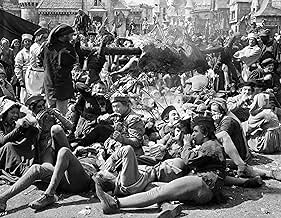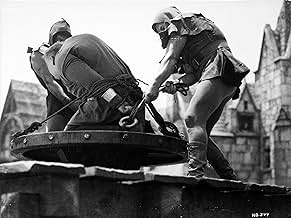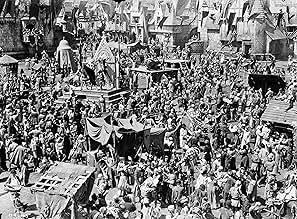El jorobado de Nuestra Señora de París
Título original: The Hunchback of Notre Dame
CALIFICACIÓN DE IMDb
7.8/10
13 k
TU CALIFICACIÓN
En la París del siglo XV, una chica gitana es incriminada en un asesinato por un juez que la desea, y solo el campanero de la ciudad puede salvarla.En la París del siglo XV, una chica gitana es incriminada en un asesinato por un juez que la desea, y solo el campanero de la ciudad puede salvarla.En la París del siglo XV, una chica gitana es incriminada en un asesinato por un juez que la desea, y solo el campanero de la ciudad puede salvarla.
- Dirección
- Guionistas
- Elenco
- Nominado a 2 premios Óscar
- 1 premio ganado y 2 nominaciones en total
Cedric Hardwicke
- Frollo
- (as Sir Cedric Hardwicke)
Helene Reynolds
- Fleur de Lys
- (as Helene Whitney)
Minna Gombell
- Queen of Beggars
- (as Mina Gombell)
Rod La Rocque
- Phillippe
- (as Rod LaRocque)
- Dirección
- Guionistas
- Todo el elenco y el equipo
- Producción, taquilla y más en IMDbPro
Opiniones destacadas
The ending differs from Hugo's novel,but I guess it was necessary to bestow on the audiences a de rigueur happy end when the world situation was getting worse and worse.It' s also dubious that king Louis XI -who died in 1483- might have been aware of Christophe Colomb's plans ,because the latter only informed the king of Portugal-who refused to put up the money for his expedition- in ...1484!
These are minor squabbles.Because this movie is definitely the finest version of Hugo's classic ,much superior to the French one ,directed by Jean Delannoy(1956) with Anthony Quinn and Gina Lollobrigida.Dieterle's work is a feast for the eyes with numerous classic scenes ,very clever dialogue,superlative performances and complete mastery of the camera.
The opening-Louis XI visiting a printing house-sums up the turning of history:Gutenberg's invention will allow the knowledge and as the King watches the cathedrals ,he makes us feel that these books of stone are fast becoming a thing of the past.The Middle Ages are coming to an end,but a lot of people ,particularly the clergy do not want to lose the power they have on the populace.When Frollo sentences Esmeralda to death,because of his sexual desire,he puts the blame on the devil.He's a man of the past,diametrically opposite to Gringoire,who epitomizes modernity,and who understands the power of the pamphlet which the printing increases tenfold.
Charles Laughton is by far the best Quasimodo that can be seen on a screen:he's so extraordinary that he almost turns the happy end into a tragedy!He gets good support from a moving and extremely beautiful O'Hara as Esmeralda and from Harwicke as Frollo.
Peaks:the fools day,the cour des miracles -maybe showing some influence by Browning's "freaks"-,all the scenes in the cathedral.Dieterle is on par with the most demanding directors all along his movie:the movements in the crowd are stunning,breathtaking,often filmed from the church towers.Humor is not absent either:Gregoire's eventful night in the cour des Miracles is colorful and funny and scary all at once.
A monument,like the cathedral itself.
These are minor squabbles.Because this movie is definitely the finest version of Hugo's classic ,much superior to the French one ,directed by Jean Delannoy(1956) with Anthony Quinn and Gina Lollobrigida.Dieterle's work is a feast for the eyes with numerous classic scenes ,very clever dialogue,superlative performances and complete mastery of the camera.
The opening-Louis XI visiting a printing house-sums up the turning of history:Gutenberg's invention will allow the knowledge and as the King watches the cathedrals ,he makes us feel that these books of stone are fast becoming a thing of the past.The Middle Ages are coming to an end,but a lot of people ,particularly the clergy do not want to lose the power they have on the populace.When Frollo sentences Esmeralda to death,because of his sexual desire,he puts the blame on the devil.He's a man of the past,diametrically opposite to Gringoire,who epitomizes modernity,and who understands the power of the pamphlet which the printing increases tenfold.
Charles Laughton is by far the best Quasimodo that can be seen on a screen:he's so extraordinary that he almost turns the happy end into a tragedy!He gets good support from a moving and extremely beautiful O'Hara as Esmeralda and from Harwicke as Frollo.
Peaks:the fools day,the cour des miracles -maybe showing some influence by Browning's "freaks"-,all the scenes in the cathedral.Dieterle is on par with the most demanding directors all along his movie:the movements in the crowd are stunning,breathtaking,often filmed from the church towers.Humor is not absent either:Gregoire's eventful night in the cour des Miracles is colorful and funny and scary all at once.
A monument,like the cathedral itself.
One of the great Hollywood films of 1939, this adaptation of Victor Hugo's novel is sumptuously put together, boasting a fine script, tight direction by German export William Dieterle, and a cast who fit their parts perfectly: Charles Laughton superb as the maligned Quasimodo; Maureen O'Hara in an early role as gypsy Esmeralda; Cedric Hardwicke as the pious Frollo; and Harry Davenport as the king, Louis XI.
The story is a version of Beauty and the Beast set within the confines of Notre Dame Cathedral and the dirt-strewn and prejudiced streets of Paris. Quasimodo, physically repulsive and deafened by the bells of the cathedral, nevertheless finds it in his childish heart to love the beautiful Esmeralda and to sacrifice his sanctuary for her. She however only has eyes for the dashing Gringoire (Edmond O'Brien) who she saves from the justice of the beggar thieves.
It is Laughton's performance that holds this film together - truly one of the greatest screen actors, capable of portraying pathos like no other. Contrast this film role with his Henry VIII or Captain Bligh and you begin to get an idea of his impressive range.
The story is a version of Beauty and the Beast set within the confines of Notre Dame Cathedral and the dirt-strewn and prejudiced streets of Paris. Quasimodo, physically repulsive and deafened by the bells of the cathedral, nevertheless finds it in his childish heart to love the beautiful Esmeralda and to sacrifice his sanctuary for her. She however only has eyes for the dashing Gringoire (Edmond O'Brien) who she saves from the justice of the beggar thieves.
It is Laughton's performance that holds this film together - truly one of the greatest screen actors, capable of portraying pathos like no other. Contrast this film role with his Henry VIII or Captain Bligh and you begin to get an idea of his impressive range.
A sweeping claim? Perhaps. But despite the presence in Hollywood over sixty subsequent years of Ford, Wyler, Kubrick, Coppola, Scorsese et al, The Hunchback of Notre Dame remains as fresh, as emotionally resonant and yes as powerfully artistic as the day it was made. What constitutes 'art' is of course a personal matter, just as the Breughel-like compositions of Hunchback might be as mystifying to someone whose favourite film is A Clockwork Orange (Lichtenstein?). But what makes Hunchback so satisfying as art is precisely that its makers didn't set out with art in mind. Dieterle and his co-creators embarked on the project with the aim of telling a great yarn, making it look authentic, and above all ENTERTAINING the audience. It is to this end that the Grand Guignol excesses of the novel were trimmed or altered, and the Hollywood bittersweet ending imposed. Audiences filed out with their Kleenex in hand having witnessed a three-ring circus of a movie, then went home to read the war-soaked newspapers.
Virtually every frame of this movie could be taken in isolation, made into a poster and hung on a wall. Examples include Gringoire cradling the dying Clopin as a rivulet of lead trickles past in the background, the voyeuristic eye of Quasimodo peering through fence palings at the dancing Esmeralda - I could go on and on. And pervading it all is the magnificent score of Alfred Newman, surely his finest ever.
Rather than sing its obvious praises, the film can simply speak for itself. As narrative, as character, as cinema craft, it is totally successful throughout. The Hunchback of Notre Dame is my favourite film of all time, bar none. Ten out of ten
Virtually every frame of this movie could be taken in isolation, made into a poster and hung on a wall. Examples include Gringoire cradling the dying Clopin as a rivulet of lead trickles past in the background, the voyeuristic eye of Quasimodo peering through fence palings at the dancing Esmeralda - I could go on and on. And pervading it all is the magnificent score of Alfred Newman, surely his finest ever.
Rather than sing its obvious praises, the film can simply speak for itself. As narrative, as character, as cinema craft, it is totally successful throughout. The Hunchback of Notre Dame is my favourite film of all time, bar none. Ten out of ten
I remember `Super Channel' showed this regularly about 10 years ago. The opening 1/2 hour is superb, with several outstanding scenes and very haunting music.The cast is brilliant, not only do you get Laughton but also Maureen O'Hara, Cedric Hardwicke and Edmon O'Brien. And Thomas Mitchell is the man! All in all a most satisfying film: 8.5 out of 10
10llltdesq
The best of the many versions of The Hunchback of Notre Dame, for my money, is this one, although Lon Chaney's is a close second. Despite a Hollywood tendancy to change the novel's ending so as not to depress the cash customers (although, pray tell, if you're going to change the ending, why does no one ever see Quasimodo sailing off to Tahiti with the girl? Rule # 1: strong, handsome poets beat out disfigured cripples every time, even if they're heroes. This is more true in real life than in the movies. Take my word for this, I know from painful experience *sigh*)
Charles Laughton is exceptional and Maureen O'Hara would make any man swoon and is perfect for the part of Esmerelda. The support includes the usual suspects-Thomas Mitchell, Harry Davenport and many other familiar character actors. Strike up the band and start the parade. Thunderous applause. Most highly recommended.
Charles Laughton is exceptional and Maureen O'Hara would make any man swoon and is perfect for the part of Esmerelda. The support includes the usual suspects-Thomas Mitchell, Harry Davenport and many other familiar character actors. Strike up the band and start the parade. Thunderous applause. Most highly recommended.
¿Sabías que…?
- TriviaFor the scene in which Quasimodo is whipped, Charles Laughton instructed an assistant director to twist his ankle outside of camera range so he would really be in pain. Even through the heavy hump and rubber body suit, he felt every lash and often came home badly bruised. Before the 16th take, director William Dieterle whispered to him, "Now, Charles, listen to me. Let's do it one more time, but this time I want you . . . I want you to suffer." According to Laughton's wife, Elsa Lanchester, the actor never forgave him for that.
- ErroresThe cathedral is shown as having a full flight of steps up to the front doors. Notre Dame has always been more or less level with the square (le Parvis).
- Citas
[Last lines]
Quasimodo, the bell-ringer: [to one of the stone gargoyles] Why was I not made of stone - like thee?
- Créditos curiososPROLOGUE: "With the end of the 15th Century, the Middle Ages came to a close. Europe began to see great changes. France, ravaged by a hundred years of war, at last found peace. The people under Louis XI felt free to hope again --- to dream of progress. But superstition and prejudice often stood in the way, seeking to crush the adventurous spirit of man."
- Versiones alternativasAlso available in a computer colorized version.
- ConexionesEdited into The Clock (2010)
- Bandas sonorasAve Maria
(1572) (uncredited)
Music by Tomás Luis de Victoria
Sung by mixed chorus during opening credits
Selecciones populares
Inicia sesión para calificar y agrega a la lista de videos para obtener recomendaciones personalizadas
Detalles
- Fecha de lanzamiento
- País de origen
- Sitio oficial
- Idioma
- También se conoce como
- The Hunchback of Notre Dame
- Locaciones de filmación
- Productora
- Ver más créditos de la compañía en IMDbPro
Taquilla
- Presupuesto
- USD 1,800,000 (estimado)
- Tiempo de ejecución1 hora 56 minutos
- Color
- Relación de aspecto
- 1.37 : 1
Contribuir a esta página
Sugiere una edición o agrega el contenido que falta

Principales brechas de datos
By what name was El jorobado de Nuestra Señora de París (1939) officially released in India in English?
Responda






































